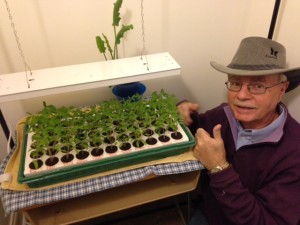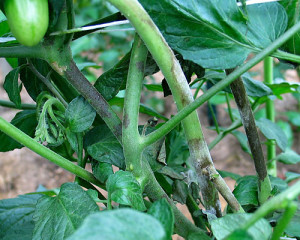This Is One Determined Gardener
April 19th, 2016
Joe Mateer isn’t about to let a little thing like the disease that caused the great Irish potato famine stand in the way of growing a decent back-yard tomato.

Joe Mateer nursing his 2016 tomato seedlings… so far blight-free (him and the tomatoes). (Photo by Norma Mateer)
This retired Lower Swatara Twp. middle-school principal loves his home-grown tomatoes and enjoyed bountiful harvests of them summer after summer for decades.
Until last year.
Just as he’d normally be swimming in ‘mater heaven, blackish spots started showing up on his tomato leaves and stems. Instead of ripening, the fruits started getting what looked like soggy spots. Then the plants turned sickly and began dropping leaves.
It all happened within the space of a week, too.
The culprit? A case of late blight, caused by the same pathogen (Phytophthora infestans) that took down nearly all of Ireland’s potato crops in the mid-1800s.
“This had never happened to me before in 40 years of gardening,” Joe laments.
He’s determined that it’s not going to happen again either… very determined.
In fact, Joe is the most determined tomato gardener I’ve ever seen. Mr. Phytophthora picked the wrong gardener to pick on.
“After months of soothing my ego – OK, a good few hours anyway – I decided to fight back,” Joe says. “I developed a fool-proof plan at redemption!”
He meticulously researched every detail he could find on late blight (actually he Googled it) and read tomatophile Craig LeHoullier’s 2015 book “Epic Tomatoes,” a tome that describes how to grow tomatoes that will “move you to tears.”
Armed with blight-fighting knowledge, Joe developed what sounds like the botanical equivalent of a military strike.
He got rid of half of the soil in his raised-bed gardens and replaced it with a blend of Baccto potting mix, three kinds of compost, a bag of peat moss and a bag of vermiculite.
He spent the winter bleaching “every gardening tool I own to eradicate that fungus.”
Then he concocted a disinfectant that he used to spray his tomato supports and raised-bed boxes.
Next, he sought out the highest-performing, most-recommended tomato varieties he could find, ordered seeds, and with the help of his gardener wife, Norma, started them under a new indoor grow-light setup.
Assuming all goes well until frost-free time, Joe plans to give each plant 4 feet of breathing room at outdoor planting this year – way more spacing than usual but something that’s recommended to aid the air flow that can dry leaves and make them less susceptible to blight.
He also plans to plant in holes that are loosened and improved to at least 1 foot wide and 1 foot deep.
And then the real test begins.
“I will diligently spray the tomatoes with a special fungus spray I created just for this purpose – that is, if I can find the paper I wrote the recipe down on,” Joe says. “I will water the new tomatoes by hand and never use the spray from the hose. Then I will pick the gorgeous tomatoes and enjoy the creative bounty! What could possibly go wrong?”
I say, “Nothing will go wrong, not even a stinkbug attack, the arrival of a new deer herd or an ill-timed hail storm!”
Joe deserves his tomatoes, and he will earn every last bite this season.
I can relate to this, and if you’re a vegetable gardener, you probably can, too.
Nothing beats the flavor and satisfaction of picking a juicy, plump, sweet, jewel-red tomato from the summer garden.
The tomato is the garden’s crowning glory – the pinnacle of plantdom and the summit of soil-finagling. Its allure is what keeps us digging and watering and chasing the dratted groundhogs out of the yard.
I can’t imagine a summer without a steady supply of garden-grown tomatoes.
And I don’t take for granted that it’s a given, as Joe’s tomato travails teach.

The lesions on this tomato sign is a sign of late blight.
Late blight is a disease that can strike any of our gardens any summer. It’s far worse than even the increasing woes we fight with septoria leaf spot and early blight – diseases that also kill but gradually enough that you have warning if you decide to take action.
Late blight swoops in and kills your whole crop almost before you even notice. Fortunately, it isn’t terribly common, although it flares up every few years here and there.
It’s a much bigger threat to tomato and potato farmers, who stand to lose their entire year’s income in a week’s time.
All that we home gardeners stand to lose is a little gardening pride and our fresh pickings.
But that’s no minor setback if you’re a tomato-gardening connoisseur. Just ask Joe.







